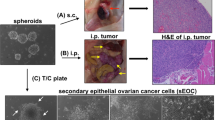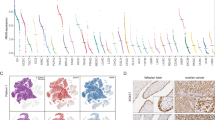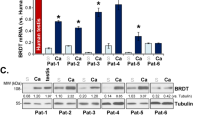Abstract
We have previously demonstrated that Krüppel-like factor 8 (KLF8) participates in oncogenic transformation of mouse fibroblasts and is highly overexpressed in human ovarian cancer. In this work, we first correlated KLF8 overexpression with the aggressiveness of ovarian patient tumors and then tested if KLF8 could transform human ovarian epithelial cells. Using the immortalized non-tumorigenic human ovarian surface epithelial cell line T80 and retroviral infection, we generated cell lines that constitutively overexpress KLF8 alone or its combination with the known ovarian oncogenes c-Myc, Stat3c and/or Akt and examined the cell lines for anchorage-independent growth and tumorigenesis. The soft agar clonogenic assay showed that T80/KLF8 cells formed significantly more colonies than the mock cells. Interestingly, the cells expressing both KLF8 and c-Myc formed the largest amounts of colonies, greater than the sum of colonies formed by the cells expressing KLF8 and c-Myc alone. These results suggested that KLF8 might be a weak oncogene that works cooperatively with c-Myc to transform ovarian cells. Surprisingly, overexpression of KLF8 alone was sufficient to induce tumorigenesis in nude mice resulting in short lifespan irrespective of whether the T80/KLF8 cells were injected subcutaneously, intraperitoneally or orthotopically into the ovarian bursa. Histopathological studies confirmed that the T80/KLF8 tumors were characteristic of human serous ovarian carcinomas. Comparative expression profiling and functional studies identified the cell cycle regulators cyclin D1 and USP44 as primary KLF8 targets and effectors for the T80 transformation. Overall, we identified KLF8 overexpression as an important factor in human ovarian carcinoma pathogenesis.
This is a preview of subscription content, access via your institution
Access options
Subscribe to this journal
Receive 50 print issues and online access
$259.00 per year
only $5.18 per issue
Buy this article
- Purchase on Springer Link
- Instant access to full article PDF
Prices may be subject to local taxes which are calculated during checkout





Similar content being viewed by others
References
Jemal A, Murray T, Ward E, Samuels A, Tiwari RC, Ghafoor A et al. Cancer statistics, 2005. CA Cancer J Clin 2005; 55: 10–30.
Liu J, Yang G, Thompson-Lanza JA, Glassman A, Hayes K, Patterson A et al. A genetically defined model for human ovarian cancer. Cancer Res 2004; 64: 1655–1663.
Rosen DG, Yang G, Bast RC, Liu J . Use of Ras-transformed human ovarian surface epithelial cells as a model for studying ovarian cancer. Methods Enzymol 2006; 407: 660–676.
Yang G, Thompson JA, Fang B, Liu J . Silencing of H-ras gene expression by retrovirus-mediated siRNA decreases transformation efficiency and tumorgrowth in a model of human ovarian cancer. Oncogene 2003; 22: 5694–5701.
Orsulic S, Li Y, Soslow RA, Vitale-Cross LA, Gutkind JS, Varmus HE . Induction of ovarian cancer by defined multiple genetic changes in a mouse model system. Cancer Cell 2002; 1: 53–62.
Cheng JQ, Godwin AK, Bellacosa A, Taguchi T, Franke TF, Hamilton TC et al. AKT2, a putative oncogene encoding a member of a subfamily of protein-serine/threonine kinases, is amplified in human ovarian carcinomas. Proc Natl Acad Sci USA 1992; 89: 9267–9271.
Cheng JQ, Jiang X, Fraser M, Li M, Dan HC, Sun M et al. Role of X-linked inhibitor of apoptosis protein in chemoresistance in ovarian cancer: possible involvement of the phosphoinositide-3 kinase/Akt pathway. Drug Resist Updat 2002; 5: 131–146.
Fang Q, Naidu KA, Zhao H, Sun M, Dan HC, Nasir A et al. Ascorbyl stearate inhibits cell proliferation and tumor growth in human ovarian carcinoma cells by targeting the PI3K/AKT pathway. Anticancer Res 2006; 26: 203–209.
Liu AX, Testa JR, Hamilton TC, Jove R, Nicosia SV, JQ Cheng . AKT2, a member of the protein kinase B family, is activated by growth factors, v-Ha-ras, and v-src through phosphatidylinositol 3-kinase in human ovarian epithelial cancer cells. Cancer Res 1998; 58: 2973–2977.
Yang H, He L, Kruk P, Nicosia SV, Cheng JQ . Aurora-A induces cell survival and chemoresistance by activation of Akt through a p53-dependent manner in ovarian cancer cells. Int J Cancer 2006; 119: 2304–2312.
Yuan ZQ, Feldman RI, Sussman GE, Coppola D, Nicosia SV, Cheng JQ . AKT2 inhibition of cisplatin-induced JNK/p38 and Bax activation by phosphorylation of ASK1: implication of AKT2 in chemoresistance. J Biol Chem 2003; 278: 23432–23440.
Yuan ZQ, Sun M, Feldman RI, Wang G, Ma X, Jiang C et al. Frequent activation of AKT2 and induction of apoptosis by inhibition of phosphoinositide-3-OH kinase/Akt pathway in human ovarian cancer. Oncogene 2000; 19: 2324–2330.
Zheng J, Mercado-Uribe I, Rosen DG, Chang B, Liu P, Yang G et al. Induction of papillary carcinoma in human ovarian surface epithelial cells using combined genetic elements and peritoneal microenvironment. Cell Cycle 2010; 9: 140–146.
Yue P, Zhang X, Paladino D, Sengupta B, Ahmad S, Holloway RW et al. Hyperactive EGF receptor, Jaks and Stat3 signaling promote enhanced colony-forming ability, motility and migration of cisplatin-resistant ovarian cancer cells. Oncogene 2012; 31: 2309–2322.
Flesken-Nikitin A, Choi KC, Eng JP, Shmidt EN, Nikitin AY . Induction of carcinogenesis by concurrent inactivation of p53 and Rb1 in the mouse ovarian surface epithelium. Cancer Res 2003; 63: 3459–3463.
Shan W, Liu J . Epithelial ovarian cancer: focus on genetics and animal models. Cell Cycle 2009; 8: 731–735.
Yang H, Kong W, He L, Zhao JJ, O’Donnell JD, Wang J et al. MicroRNA expression profiling in human ovarian cancer: miR-214 induces cell survival and cisplatin resistance by targeting PTEN. Cancer Res 2008; 68: 425–433.
Johnson NC, Dan HC, Cheng JQ, Kruk PA . BRCA1 185delAG mutation inhibits Akt-dependent, IAP-mediated caspase 3 inactivation in human ovarian surface epithelial cells. Exp Cell Res 2004; 298: 9–16.
Yang F, Guo X, Yang G, Rosen DG, Liu J . AURKAand BRCA2 expression highly correlate with prognosis of endometrioid ovarian carcinoma. Mod Pathol 2011; 24: 836–845.
Yang G, Chang B, Yang F, Guo X, Cai KQ, Xiao XS et al. Aurora kinase A promotes ovarian tumorigenesis through dysregulation of the cell cycle and suppression of BRCA2. Clin Cancer Res 2010; 16: 3171–3181.
Zhou C, Huang P, Liu J . The carboxyl-terminal of BRCA1 is required for subnuclear assembly of RAD51 after treatment with cisplatin but not ionizing radiation in human breast and ovarian cancer cells. Biochem Biophys Res Commun 2005; 336: 952–960.
Zhou C, Liu J . Inhibition of human telomerase reverse transcriptase gene expression by BRCA1 in human ovarian cancer cells. Biochem Biophys Res Commun 2003; 303: 130–136.
Zhou C, Smith JL, Liu J . Role of BRCA1 in cellular resistance to paclitaxel and ionizing radiation in an ovarian cancer cell line carrying a defective BRCA1. Oncogene 2003; 22: 2396–2404.
Connolly DC, Bao R, Nikitin AY, Stephens KC, Poole TW, Hua X et al. Female mice chimeric for expression of the simian virus 40 TAg under control of the MISIIR promoter develop epithelial ovarian cancer. Cancer Res 2003; 63: 1389–1397.
van Vliet J, Turner J, Crossley M . Human Kruppel-like factor 8: a CACCC-box binding protein that associates with CtBP and represses transcription. Nucleic Acids Res 2000; 28: 1955–1962.
Wang X, Lu H, Urvalek AM, Li T, Yu L, Lamar J et al. KLF8 promotes human breast cancer cell invasion and metastasis by transcriptional activation of MMP9. Oncogene 2011; 30: 1901–1911.
Wei H, Wang X, Gan B, Urvalek AM, Melkoumian ZK, Guan JL et al. Sumoylation delimits KLF8 transcriptional activity associated with the cell cycle regulation. J Biol Chem 2006; 281: 16664–16671.
Zhao J, Bian ZC, Yee K, Chen BP, Chien S, Guan JL . Identification of transcription factor KLF8 as a downstream target of focal adhesion kinase in its regulation of cyclin D1 and cell cycle progression. Mol Cell 2003; 11: 1503–1515.
Zhang P, Basu P, Redmond LC, Morris PE, Rupon JW, Ginder GD et al. A functional screen for Kruppel-like factors that regulate the human gamma-globin gene through the CACCC promoter element. Blood Cells Mol Dis 2005; 35: 227–235.
Wang X, Zheng M, Liu G, Xia W, McKeown-Longo PJ, Hung MC et al. Kruppel-like factor 8 induces epithelial to mesenchymal transition and epithelial cell invasion. Cancer Res 2007; 67: 7184–7193.
Li JC, Yang XR, Sun HX, Xu Y, Zhou J, Qiu SJ et al. Up-regulation of Kruppel-like factor 8 promotes tumor invasion and indicates poor prognosis for hepatocellular carcinoma. Gastroenterology 2010; 139: 2146–2157.e12.
Urvalek AM, Lu H, Wang X, Li T, Yu L, Zhu J et al. Regulation of the oncoprotein KLF8 by a switch between acetylation and sumoylation. Am J Transl Res 2011; 3: 121–132.
Urvalek AM, Wang X, Lu H, Zhao J . KLF8 recruits the p300 and PCAF co-activators to its amino terminal activation domain to activate transcription. Cell Cycle 2010; 9: 601–611.
Wang X, Urvalek AM, Liu J, Zhao J . Activation of KLF8 transcription by focal adhesion kinase in human ovarian epithelial and cancer cells. J Biol Chem 2008; 283: 13934–13942.
Zhao J, Guan JL . Signal transduction by focal adhesion kinase in cancer. Cancer Metastasis Rev 2009; 28: 35–49.
Eaton SA, Funnell AP, Sue N, Nicholas H, Pearson RC, Crossley M . A network of Kruppel-like Factors (Klfs). Klf8 is repressed by Klf3 and activated by Klf1 in vivo. J Biol Chem 2008; 283: 26937–26947.
Lu H, Wang X, Li T, Urvalek AM, Yu L, Li J et al. Identification of poly (ADP-ribose) polymerase-1 (PARP-1) as a novel Kruppel-like factor 8-interacting and -regulating protein. J Biol Chem 2011; 286: 20335–20344.
Mehta TS, Lu H, Wang X, Urvalek AM, Nguyen KH, Monzur F et al. A unique sequence in the N-terminal regulatory region controls the nuclear localization of KLF8 by cooperating with the C-terminal zinc-fingers. Cell Res 2009; 19: 1098–1109.
Wang X, Zhao J . KLF8 transcription factor participates in oncogenic transformation. Oncogene 2007; 26: 456–461.
Fu WJ, Li JC, Wu XY, Yang ZB, Mo ZN, Huang JW et al. Small interference RNA targeting Kruppel-like factor 8 inhibits the renal carcinoma 786-0 cells growth in vitro and in vivo. J Cancer Res Clin Oncol 2010; 136: 1255–1265.
Liu L, Liu N, Xu M, Liu Y, Min J, Pang H et al. Lentivirus-delivered Kruppel-like factor 8 small interfering RNA inhibits gastric cancer cell growth in vitro and in vivo. Tumour Biol 2012; 33: 53–61.
Cox BD, Natarajan M, Stettner MR, Gladson CL . New concepts regarding focal adhesion kinase promotion of cell migration and proliferation. J Cell Biochem 2006; 99: 35–52.
Schnell O, Romagna A, Jaehnert I, Albrecht V, Eigenbrod S, Juerchott K et al. Kruppel-like factor 8 (KLF8) is expressed in gliomas of different WHO grades and is essential for tumor cell proliferation. PLoS One 2012; 7: e30429.
Wan W, Zhu J, Sun X, Tang W . Small interfering RNA targeting Kruppel-like factor 8 inhibits U251 glioblastoma cell growth by inducing apoptosis. Mol Med Report 2012; 5: 347–350.
Stegmeier F, Rape M, Draviam VM, Nalepa G, Sowa ME, Ang XL et al. Anaphase initiation is regulated by antagonistic ubiquitination and deubiquitination activities. Nature 2007; 446: 876–881.
Lahiri SK, Zhao J . Kruppel-like factor 8 emerges as an important regulator of cancer. Am J Transl Res 2012; 4: 357–363.
Evans PM, Liu C . Roles of Krupel-like factor 4 in normal homeostasis, cancer and stem cells. Acta Biochim Biophys Sin 2008; 40: 554–564.
Gumireddy K, Li A, Gimotty PA, Klein-Szanto AJ, Showe LC, Katsaros D et al. KLF17 is a negative regulator of epithelial-mesenchymal transition and metastasis in breast cancer. Nat Cell Biol 2009; 11: 1297–1304.
McConnell BB, Yang VW . Mammalian Kruppel-like factors in health and diseases. Physiol Rev 2010; 90: 1337–1381.
Suresh B, Ramakrishna S, Lee HJ, Choi JH, Kim JY, Ahn WS et al. K48- and K63-linked polyubiquitination of deubiquitinating enzyme USP44. Cell Biol Int. 2010; 34: 799–808.
Kang X, Sun L, Guo K, Shu H, Yao J, Qin X et al. Serum protein biomarkers screening in HCC patients with liver cirrhosis by ICAT-LC-MS/MS. J Cancer Res Clin Oncol 2010; 136: 1151–1159.
Zhang X, Yue P, Page BD, Li T, Zhao W, Namanja AT et al. Orally bioavailable small-molecule inhibitor of transcription factor Stat3 regresses human breast and lung cancer xenografts. Proc Natl Acad Sci USA 2012; 109: 9623–9628.
Yang T, Cai SY, Zhang J, Lu JH, Lin C, Zhai J et al. Kruppel-like factor 8 is a new wnt/beta-catenin signaling target gene and regulator in hepatocellular carcinoma. PLoS One 2012; 7: e39668.
Siegel PM, Shu W, Massague J . Mad upregulation and Id2 repression accompany transforming growth factor (TGF)-beta-mediated epithelial cell growth suppression. J Biol Chem 2003; 278: 35444–35450.
Sowa ME, Bennett EJ, Gygi SP, Harper JW . Defining the human deubiquitinating enzyme interaction landscape. Cell 2009; 138: 389–403.
Acknowledgements
We thank Dr Alexander Yu Nikitin of Cornell University for helping with the intrabursal implantation techniques. We also thank all the members of Zhao lab for critical discussions and helpful comments. This work was supported by grants from NCI (CA132977), Susan G. Komen for Cure Breast Cancer Foundation (KG090444 and KG080616) and American Cancer Society (RSG CCG-111381) to JZ.
Author information
Authors and Affiliations
Corresponding author
Ethics declarations
Competing interests
The authors declare no conflict of interest.
Additional information
Supplementary Information accompanies the paper on the Oncogene website
Supplementary information
Rights and permissions
About this article
Cite this article
Lu, H., Wang, X., Urvalek, A. et al. Transformation of human ovarian surface epithelial cells by Krüppel-like factor 8. Oncogene 33, 10–18 (2014). https://doi.org/10.1038/onc.2012.545
Received:
Revised:
Accepted:
Published:
Issue Date:
DOI: https://doi.org/10.1038/onc.2012.545
Keywords
This article is cited by
-
The roles of FHL2 in cancer
Clinical and Experimental Medicine (2023)
-
KLF8 and FAK cooperatively enrich the active MMP14 on the cell surface required for the metastatic progression of breast cancer
Oncogene (2014)
-
Identification of epithelial stromal interaction 1 as a novel effector downstream of Krüppel-like factor 8 in breast cancer invasion and metastasis
Oncogene (2014)
-
Krüppel-like factors in cancer
Nature Reviews Cancer (2013)



